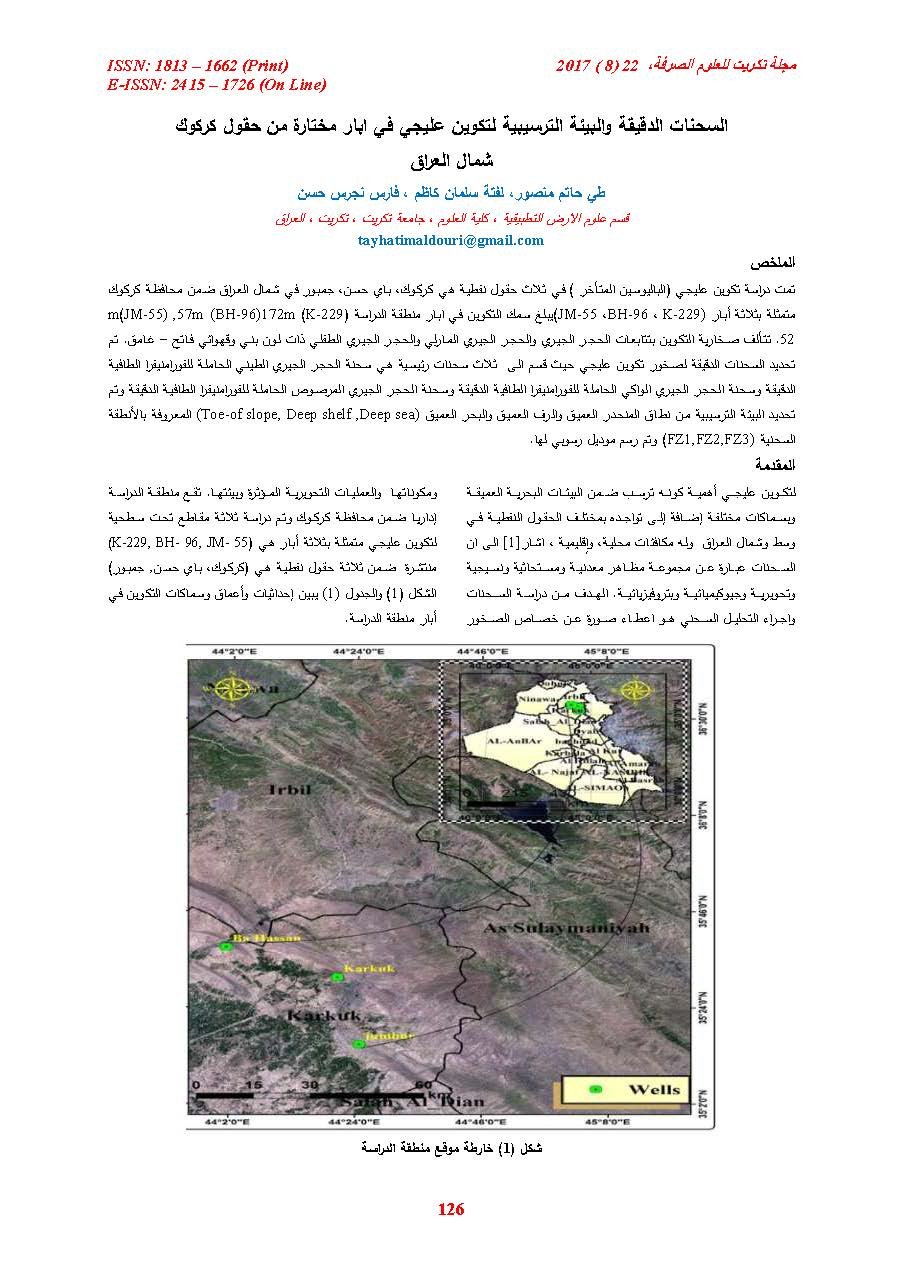Microfacies and Sedimentary environment of Aliji Formation in selected wells from Kirkuk oil fields north Iraq
Main Article Content
Abstract
The study carried out of Aliji Formation (Late Paleocene) for selected wells in three oil fields Kirkuk, Bai Hassan and Jambur The thickness of formations in the studied wells area (K-229) 172m, (BH-96) 57m,and (JM-55) 52m.
Lithological, Aliji Formation composed of limestone, marly limestone and shally limeston brown light –dark colour.
The recognized microfacies where division to three main microfacies, Planktonic foraminiferal Lime Mudstone microfacies, Planktonic Foraminiferal Lime Wackstone microfacies and Planktonic Foraminiferal Lime Packstone microfacies.
The Formation deposited in deep bathyal environment at (FZ1, FZ2, FZ3) (Toe of slope, Deep shelf, Deep sea) as indicated on the constract sedimentary model.
Article Details

This work is licensed under a Creative Commons Attribution 4.0 International License.
Tikrit Journal of Pure Science is licensed under the Creative Commons Attribution 4.0 International License, which allows users to copy, create extracts, abstracts, and new works from the article, alter and revise the article, and make commercial use of the article (including reuse and/or resale of the article by commercial entities), provided the user gives appropriate credit (with a link to the formal publication through the relevant DOI), provides a link to the license, indicates if changes were made, and the licensor is not represented as endorsing the use made of the work. The authors hold the copyright for their published work on the Tikrit J. Pure Sci. website, while Tikrit J. Pure Sci. is responsible for appreciate citation of their work, which is released under CC-BY-4.0, enabling the unrestricted use, distribution, and reproduction of an article in any medium, provided that the original work is properly cited.
References
[1] Boggs, S. Jr., 2009, Petrology of Sedimentary
Rocks, 2nd ed., Cambridge University Press ,New
York ,600p.
[2] Jassim, S.Z & Goff J.C., 2006: Geology of Iraq
Published by Dolin, Prague and Moravian Musem,
Brno,341p.
[5] Alsheikhly, Saad, S, Tamar-Agha, Mazen, Y,
Mahdi, Maher, M, 2015:Basin analysis of
Cretaceous to Tertiary selected wells in Kirkuk and
Bai Hassan Oil Fields, Kirkuk, Northern Iraq, Iraqi
Journal of Science, Vol 56, No.1B, pp: 435-443.
[6] Bellen, R.C., Van; Dunnington, H.V. Wetzel,
R., Morton, D., 1959: Lexique Strtigraphicque
International. Asie, Fascicule 10a, Iraq, Parise, 333p.
[9] Tucker, M.E., 1981: Sedemintary Petrology An
Introduction, Black Well Scientific Published,
Oxford.
[10]Tucker, M.E., 1985: Sedimentary Petrology An
Introduction, Vol.3, Black Well Scientific Published,
Oxford .,p.252.
[11] Dunham, R.J., 1962: Classification of carbonate
rocks according to depositional texture. in: Ham,
W.E. (ed.) Classification of carbonate rocks.
American Association of Petroleum Geologists, Bull.,
pp. 108–171.
[12] Gibson, T.G., 1989: Planktonic benthonic
foraminiferal ratios: Modern patterns and Tertiary
applicability. Marine Micropaleontology. Vol. 15, pp.
29-52.
[13] Flugel, E., 2004: Microfacies of Carbonate
Rocks, Analysis, Interpretation and Application.
Springer-Verlag,Berlin,996p.
[14] Boersma, A., 1978: Foraminiferal In: Haq, B.V.
and Boersma, A. (eds.), Introduction to marine
micropaleontology ,El Sevier, Sci Pub Co .New
York. pp.19-78.
[15] Douglass, R.C., 1960: Classification of the
family Orbitolinidae Micropaleontology V.6, no.3,
pp. 249-270,pls .1-6.
[16] Grafe, K.U., 2005: Late cretaceous benthic
foraminifers from the Bsque-Cantabrian Basin,
Northren Spain .jour. of Ibrian Geo., v.31, n.2, pp.
277-298.
[17] Boltovsky, E. and Wright, R.,1976: Recent
Foraminifera Dr. W. Junk b.v–publishers–The Hague.
[18] Frerich, W.E. (1971): Planktonic foraminifera
in sediments of the Andaman sea. J. Foram. Research,
V. 1, No. 1, pp. 1-14.
[19] Chilinger, G.V., Bissell, H.J. and Fairbridge,
R.W., 1967: Carbonate rock (origin, occurrence and
classification). Elsevier pub .Comp.471p.
[20] Warren, J., 2000: Dolomite , Occurrences,
evolution and Economically important association
Earth Science reviews, V. 52, 1-81.
[21] Li, Q. and McGowran, B. (1994): Miocene
upwelling events: neritic foraminiferal evidence from
Southern Australian, Journal of Earth Sciences, V.
41, pp. 593-603.
[22] Boersma, A., Premoli Silva, I. and Shackle
ton, N.J., 1987: Atlantic Eocene planktonic
Foraminiferal Palcohydrographic indicators and
stable isotopic pale oceanography . V.2, No3,pp.287-
331.
